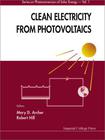清洁的光电能/CLEAN ELECTRICITY FROM PHOTOVOLTAICS
出版时间:2001-12 出版社:Pengiun Group (USA) 作者:Archer, Mary D. (EDT)/ Hill, Robert (EDT) 页数:844
内容概要
Photovoltaic cells provide clean, reversible electrical power from the sun.Made from semiconductors, they are durable, silent in operation and free of polluting emissions. In this book, experts from all sectors of the PV community- materials scientists, physicists, production engineers, economists and environmentalists -- give their critical appraisals of where the technology is now and what its prospects are.作者简介:MARY ARCHER is a Visiting Professor in the Centre for Energy Policy and Technology at Imperial College,London, a Bye-Fellow of Newnham College,Cambridge, and a ompanion of the Institute of Energy. Her long-standing interest in direct (non-thermal) means of solar energy conversion was sparked by the oil price hikes of the 1970s. At Imperial College (1966-68), the Royal Institution,London (1972-76), and the Department of Chemistry, Cambridge University (1976-86), she worked on terogeneous catalysis, photogalvanic cells, electron transfer and semiconductorphotoelectrochemistry. Since leaving full-time academia, she has served on a number of energy policy advisory bodies, including the Department of Energy's Renewable Energy Advisory Group and the DTI's Energy Advisory Panel. She co-founded the UK Solar Energy Society in the early seventies,and is now its President, and she was the founder Chairman and is now President of the National Energy Foundation, which promotes energy efficiency and renewable energy.
书籍目录
About the authorsPreface1 The past and present M. D. Archer 1.1 Milestones in photovoltaic technology 1.2 Evolution of the PV market 1.3 Overview ofphotovoltaic cell operation 1.4 Other junction types 1.5 Sources of further information2 Device physics of silicon solar cells J. O. Schumacher and W. Wettling 2.1 Introduction 2.2 Semiconductor device equations 2.3 The p-n junction model of Shockley 2.4 Real diode characteristics 2.5 Numerical solar cell modelling 2.6 Concluding remarks3 Principles of cell design J. Poortmans, J. Nijs and R. Mertens 3.1 Introduction 3.2 Main cell types 3.3 Optical design of ceils 3.4 Surface recombination losses and their reduction 3.5 Bulk recombination losses and their reduction 3.6 Design and fabrication of the metal contacts 3.7 Conclusions4 Crystalline silicon solar cells M. A. Green 4.1 Overview 4.2 Silicon cell development 4.3 Substrate production 4.4 Cell processing 4.5 Cell costs 4.6 Opportunities for improvement 4.7 Silicon-supported thin films 4.8 Summary5 Amorphous silicon solar cells C. R. Wronski and D. E. Carlson 5.1 Introduction 5.2 Background 5.3 Amorphous silicon-based materials 5.4 Growth and microstructure 5.5 Solar cells 5.6 Solar cell structures 5.7 PV modules 5.8 Manufacturing costs 5.9 Long-term reliability 5.10 Environmental issues 5.11 Challenges for the future6 Cadmium telluride solar cells D. Bonnet 6.1 Introduction 6.2 Early work 6.3 The potential of the base material 6.4 Diodes and cells 6.5 Cell production 6.6 Module production 6.7 Industrial status--achievements and projections 6.8 Economic aspects 6.9 Health and environmental aspects 6.10 Conclusions7 Cu(In,Ga)Sezsolar cells U. Rau and H. W. Schock 7.1 Introduction……8 Super-high efficiency Ⅲ-Ⅴ tandem and multijunction cells M.Yamaguchi9 Organic photovoltaic devices J.JM.Halls and R.H.Friend10 Quantum well solar cells J.Nelson11 ThermophotovoItaic generation of electricity T.J.Cortts12 Concentrator cells and systems A.Lugue13 Cells and systems for space applications C.M.Hardingham14 Storage of electrical energy R.M.Dell15 Photovoltaic modules,systems and applications N.M.Pearsall and R.Hill16 The photovoltaic business:manufacturers and markets B.McNelis17 The economics of photovoltaic technologies D.Anderson18 The ortlook for PV in the 21st century E.H.Lysen and B.YordiAppendicesIndex
图书封面
评论、评分、阅读与下载
清洁的光电能/CLEAN ELECTRICITY FROM PHOTOVOLTAICS PDF格式下载
用户评论 (总计0条)
相关图书
- 现代物理学中的计算/COMPUTATION IN MODERN PHYSICS
- 簇的实验和理论研究进展PROGRESS IN EXPERIMENTAL AND THEORETICAL STUDIES OF CLUSTERS
- 微分几何讲义LECTURES ON DIFFERENTIAL GEOMETRY
- 计算世界中的迷人国度
- 非线性重力动力学
- 信息技术及媒体经济ECONOMICS OF INFORMATION TECHNOLOGY AND THE MEDIA
- 统计力学STATISTICAL MECHANICS
- 基金组合投资管理
- 浙江省农业地质环境调查评价方法技术
- 年度学术2007
- 安全快捷驾驶爱车
- 农林信息技术
- 河北抚宁、曲阳晚古生代地层及植物群
- 论美国的民主
- 中国社会思想史资料选辑
- 民国卷-中国社会思想史资料选辑(上下)
- 中国社会思想史资料选辑
- 论民主
- 美国历届总统就职演说全集
- 毛纺生产技术275问
- 清梳联合机使用手册
- VCD/DVD机常见故障实修演练
- 西伯利亚历险记-我的第一本科学漫画书
- 中国西部开发金融制度调查报告
- 射天狼
